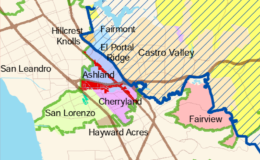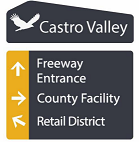Supervisors consider 90-day mobile home park rent increase moratorium
- By : Michael Kusiak
- Category : Alameda County, Economic Development, Featured Story, Governance
The Alameda County Board of Supervisors (BOS) will consider an Urgency Interim Ordinance at Tuesday, March 3’s Board meeting that would suspend all rental increases at mobile home parks in unincorporated Alameda County for 90 days and give the Community Development Agency time to develop proposed changes to the Mobile Home Park Rent Stabilization Ordinance.
The 1990 Mobile Home Park Rent Stabilization Ordinance limits rent increases to 5% annually for unincorporated residents who rent spaces in mobile home parks. The purpose of the ordinance is “to protect the owners and occupiers of mobile homes from unreasonable rent increases” while also “recognizing the need of the park owners to receive both a fair return on their property and rental income sufficient to cover increasing costs for repair, maintenance, insurance, employee service and utility government assessments.”
Under the current ordinance, only the Board of Supervisors may authorize a rent increase at a mobile home park in unincorporated Alameda County above the maximum 5% annual increase. A mobile home park owner who would like a greater increase must file a petition with the Board that contains “relevant and detailed documentation supporting the level of rent increase requested” and pay a $300 fee.
In the staff letter recommending the approval of the proposed ordinance, CDA Director Chris Bazar states that only one mobile home park owner has sought a rental increase since the ordinance was put in place nearly 25 years ago. The Board of Supervisors denied that request.
Recently, CDA has “received a significant number of complaints” by mobile home park residents, per Bazar’s letter.
According to complaints, rents are increased each year with no relation to increase in costs. If space rents are increased 5% per year, the cumulative impact is to make the space rental prohibitively expensive: for example space rents can increase 25% over five years.
In supporting the adoption of the 90-day moratorium that would be in effect from March 3, 2015 through June 1, 2015, the Urgency Interim Ordinance states that a “review of the mobile home rent stabilization ordinances of surrounding communities reveals that Alameda County’s maximum rent increase has resulted in the highest yearly rent increase in the area repeatedly.”
Bazar points to an alternative rental increase formula, based on the Consumer Price Index (CPI), and used by the “vast majority” of the 95 jurisdictions in California that have rent control ordinances for mobile home parks. The overall CPI declined by .1% in January, while the the component of the CPI that tracks the cost of shelter was up by 2.9%.
Differences between mobile homes and apartment/house rentals
Unlike renters of apartments or houses, “Residents of mobile home parks own their own coaches, and rent the land on which their coaches sit,” according to Bazar’s letter. Additionally, mobile homes are relatively immobile. Mobile home residents “are not generally able to move their coaches to other parks, as these units are generally older and would not stand up to the rigors of travel and may not even be accepted by another park.”
Renters in mobile home parks are the only residents in unincorporated Alameda County with rent control. Residents who rent an apartment or home are not covered by rent control, but are are covered by a rent mediation services ordinance from 2014, including the residents of the Park Towers apartments who are facing significant rental increases.
The Zillow Rent Index currently values the median rent in Castro Valley at $2,682 per month, based on data through January 31, 2015.
Life in Castro Valley’s mobile home parks

According to the Golden State Manufactured-home Owners League, “a nonprofit homeowner advocacy organization, dedicated to protecting the rights and quality of life of manufactured home owners,” since the 1970s, “very few new manufactured home parks were constructed in California.”
There are seven mobile home parks and one recreational vehicle (RV) park with spaces for up to 310 mobile homes and 15 RVs in Castro Valley, according to the mobile home search tool maintained by the California Department of Housing and Community Development.
In researching this post, I spoke with the owner of a mobile home park, and I walked over to two mobile home parks in my neighborhood to ask my neighbors questions about the moratorium and what it is like living in a mobile home.
One mother, a life-long resident of Castro Valley, who appreciated the affordability of her rent, about $475 a month, and the lack of crime. She said that her landlord was responsive, and other than maybe having access to more washers and dryers, that she liked where she lived.
At another park, a resident who lost her home during the home foreclosure crisis earlier in the decade, said that owning a mobile home and renting a space gave a greater sense of security than living in an apartment. In an older park like hers, she said, residents faces problems with aging infrastructure, such as the electrical system.
“Mobile home park owners are already providing the lowest cost service for living in Bay Area,” the mobile home park owner said, citing monthly rents of about $500 – $825 for a mobile home or RV space in Castro Valley. The owner believes that “rent control has worked” and said that not all property owners raise their rents by the maximum 5% each year.
If passed, the owner believes that the moratorium will last more than 90 days and could negatively affect investments at mobile home parks. “Costs go up every year for infrastructure and repairs. Costs also go up for taxes, maintenance, utilities, insurance costs, and repairs and replacements. Without rent increases on the horizon, it could jeopardize capital improvements.”
If the Supervisors pass the Urgency Interim Ordinance, CDA expects that multiple County commissions and committees, including the Castro Valley Municipal Advisory Council (MAC), will provide review of any possible amendments or a new ordinance in March and April.
Live in a mobile home park? Do you manage or own a mobile home park? Facing a big rent increase? Share your thoughts in the comments sections, on Facebook, or on Twitter with hashtag #CVrents.



Can’t let that math error (from the letter) slide. Due to the miracle of compounding, a rent increase of 5% per year adds up to 27.6% after 5 years.
What? The County made a mathematical error? Shocking!!
Ha, that was bugging me, too. Very tempted to add a [sic] to the quote from the letter . . .
Housing affordability is a huge issue that will impact our kids and their ability to live in this wonderful Bay Area, and mobile homes are an important option in the tight housing market. It’s nice that CV has a comparatively large number of them. Yet It seems as those these parcels have aged in a not-so-graceful way, all the while the rents continue to climb. I wonder if there are ways that owners and the community could partner to make these parks more of an asset for CV. Shared meeting space for residents’ parties, a small playground for kids? Thanks for shedding some light on this issue!
Trying to find a space for 5th wheel, like new. One adult. Can’t see names of all mobile home parks. Can you help me out?